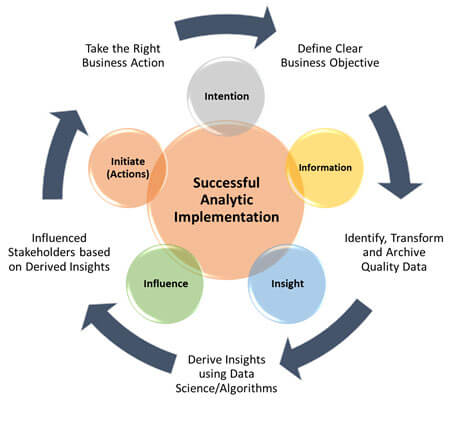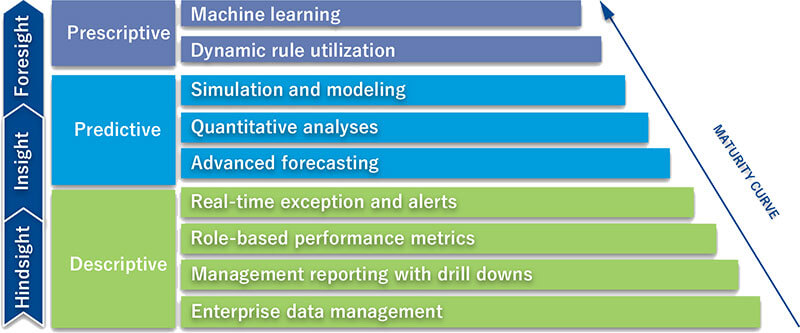Effective use of Analytics as a business tool can have a huge impact on the operations of companies. Organizations are more aware now than ever before of this utility. Analytics combined with Business Intelligence tools have proven to be of immense advantage to corporates, the world over. The tools provide the much elusive competitive edge by impacting all three sections of corporate value:
- Financial – Diagnostic analytics enables companies to extract valuable insights for decision-making and acts as a growth accelerator opening new revenue streams
- Customer – Customer Analytics facilitate better customer engagement, and support customer-centric business transformation
- Compliance – Risk Analytics help identify and respond to risks, addressing regulatory requirements while continuous control monitoring helps companies to extract abnormalities from their transaction data by applying pre-determined risk scenarios for the early detection of fraud or errors
The two main barriers that most organizations confront when trying to realize the benefits of analytics are the lack of technological integration and the inability to secure and develop proper personnel. Many businesses are making investments in data analytics, but the required skills are still in their infancy. Only a small number of businesses have been able to make the necessary investments to successfully overcome these challenges and get the end-state benefits so typically associated with the effective application of data analytics.
Reason for Failure
To stay ahead of markets and trends, various decision-makers across departments within enterprises have begun improvising and developing their own ad-hoc Business Intelligence and Analytics solutions that cannot be extended and are not validated to provide accurate insight to ensure successful outcomes. Many companies are grappling with a corporate context crisis as a result of executives' lack of access to a comprehensive single version of the ‘truth' across structured and unstructured data environments. A fragmented approach to data mining and analysis frequently results in various executives within the same business dealing with different versions of the same data. This, in turn, leads to conflicting conclusions with contradictory opinions about the best actions to take going forward, and it continues to worsen as additional business units and geographical regions of operation get involved, not just in daily decision-making, but even in the strategic planning process.
The two main barriers that most organizations confront when trying to realize the benefits of analytics are the lack of technological integration and the inability to secure and develop proper personnel.
Most Business Intelligence and Analytics deployments are fragmented and compartmentalized. The traditional fragmented approach may be ascribed largely to the advent of new low-cost point solutions for data analysis, which has encouraged executives from each business unit or department to deploy their own Business Intelligence & Analysis tools and methodologies. This ’democratization’ of BI&A has resulted in an unregulated proliferation of tools, local data, and other services which has added to the enterprise’s complexity and confusion as diverse interest groups struggle to make sense of data that impacts various aspects of Shared Services operations.
Addressing the Challenges
We are seeing a growing amount of evidence to support the notion that analytics is more than just a recent catchphrase to describe enhanced traditional business intelligence or better reporting. For Shared Services leaders, analytics can provide a multifaceted approach to producing quantifiable value that can be utilized. Organizations frequently fall short of realizing the full analytics potential because they believe that successful analytics must be IT-driven and involve the collection of data from many systems before it can be used in an analysis solution. SSCs should view analytics “as a service”, which they can offer both to their own functional teams and to their internal business clients, much like finance or HR. An organization's analytics capabilities should complement its business strategy by providing insight into the underlying force that propels it forward. Organizational culture, structure, and readiness, all influence the way analytics initiatives are implemented. SSC maturity and/ or partnerships with outsourced services providers also play a role. In order to move analytics up the analytics value chain, at the outset, SSC/ GBS leaders must define what will work for the organization as a whole.
The Opportunity Within Shared Services
The logical step in the evolution of Shared services is to include increasingly intricate value-adding procedures in their delivery setup. BPO and KPO processes coexist rather happily in most well-established shared services firms. After the transactional activity has stabilized, every process tends to absorb a certain amount of BI activities. While this constitutes a step forward for the delivery teams, these teams generally encounter systemic and operational challenges that prevent them from properly scaling up these activities. New capabilities must be built to meet the business's ever-increasing complicated analytics needs. A single delivery framework is the greatest way to scale up operations and generate stronger capabilities.
New capabilities must be built to meet the business's ever-increasing complicated analytics needs. A single delivery framework is the greatest way to scale up operations and generate stronger capabilities.
BI/ Analytics as a centralized function is becoming increasingly popular among companies due to a number of compelling commercial factors. One of the primary reasons for this is the increased efficiency that comes with larger-scale operations. However, there is a strong business driver that may be more significant in the long term.
Typically, Analytics teams are set up by business functions for whom establishing ROI in money (growth in sales or qualified leads, for example) is easier. Most business departments will be able to employ Analytics to develop strategic insights for their organization if they have a centralized BI/ Analytics configuration in a shared services environment.
There is however, no such thing as a one-size-fits-all strategy as much relies on the SSC's connection with the business units, including whether it has ‘business authorization’ to centralize analytics capabilities and provide some of the more advanced insight offerings.
Some of the most important BI/ Analytics value propositions are:
- Provide businesses with efficient and effective analytics and reporting services offering strategic value to the stakeholders.
- Better business decisions are to be made with the help of corporate data insights.
- A centralized BI delivery structure is essential for creating data governance and other critical objectives like service level agreements and a governance model.
- Only a centralized, controlled implementation of reporting and analytics capabilities allows for true collaboration and consolidation.
- The goal of Business Intelligence (BI) is to deliver the correct information to the correct decision-makers at the correct time. The best initial step will be to centralize the distinct reporting capabilities.
Tools and Framework for Implementation
Thankfully, implementation is not as onerous as it once was. R and Python are the most commonly used tools for data analytics, while the most popular BI tools in the market are Tableau, Power BI and FineReport. There are also a few upcoming tools such as Qlikview, Rapidminer and Apache Spark. Some commonly used tools empower BI analysts with a re-useable workflow for self-service data prep, so one can spend less time preparing data and invest more time analyzing. To undertake proper and comprehensive implementation, a basic framework that is commonly used, with some customisation, can be:

Creating a Vision for the Future

The Analytics department, like many others in an organization, benefits from standardization. Enterprises can achieve greater scale by creating repeatable procedures and centralizing capabilities. Analytical insights should not be generated in a vacuum but should be used in conjunction with other aspects of the business. The Analytics department must be closely linked to the business's demands and show flexibility as needs evolve. It must play the role of a young and emerging function, possibly more so than any other support function.SSCs have traditionally placed a high value on developing and maintaining long-term relationships with their business customers.
With the correct governance and capabilities in place, Analytics teams can build on these relationships to provide advice and personalized solutions to specific business problems, as well as create further demand for analytics initiatives. Data-driven business insights can show where investments are needed to transform and optimize processes, uncover performance gaps, and discover new revenue development prospects. Dashboards and analytics allow shared service executives and line managers better oversee performance.
In terms of analytical maturity, organizations are now at varying stages. Several have already begun to enhance their processes without utilizing their SSOs. Nevertheless, SSOs can play a role at every point of the maturity curve and help firms evolve faster.
To drive analytics competence in their businesses, SSOs can refer to the Analytics Maturity Model, from foundation to cognitive stages, to better understanding the analytics progression, based upon the amount of value-added to an organization versus the complexity it takes to implement.
Using data analytics to improve forecasting, cash flow visibility, risk management, and customer churn & retention management will become the standard. Specifically suggesting personalized credit rules for client acquisition at a very granular level in order to enhance healthy revenue growth, customer retention, and customer lifetime value. Data-driven business insights will show where investments are needed to change and enhance processes, discover performance gaps to better people management, and reveal new revenue development possibilities.

As most organizations start on this journey, there are a few key activities SSOs can begin to work on to position themselves appropriately:
- Using existing SSO functional expertise to pilot analytically driven initiatives. Finding a way to demonstrate to the rest of the organization how the SSO can effectively support analytics (e.g., workforce planning in HR).
- Encouraging the development of analytically minded employees within the company. Taking advantage of the SSO's reporting teams to find the employees who can go beyond ’scorekeeping’ and start ’storytelling.’
- Creating internal analytic teams by recruiting people from all over the organization. Bringing these groups into the SSO by pitching to them the advantages of a centrally managed analytics ’COE’ in the organization
- Focusing on integrating technology at one or two places within the company. Increasing cross-functional analytic capabilities by using one to two technological platforms that can be influenced and identified. Focusing on short-term tasks that can help integrate data (e.g., combining multiple Enterprise Resource Plans).
- Investing in robust, platform-independent BI tools. Making use of current SSO reporting requirements to advance the need for robust BI tools that will support future analytic capabilities.
Conclusion
Using a GBS or SSC to deliver analytics is a long road and there may be issues and setbacks along the way, as probably no organization has made the shift completely. Not every analytics project will be successful, and not every attempt at innovation will result in a significant increase in earnings. The easiest way to integrate analytics into an SSC or GBS is to focus on little tweaks rather than significant transformations. Organizations should proceed cautiously and gradually integrate analytics into all aspects of daily operations. It may be best to begin with simple changes that will help develop a strategic vision and realize the full potential of analytics. The transition from a backward-looking function that reacts to historical data to one that predicts ahead through analysis necessitates careful planning.
Organizations should proceed cautiously and gradually integrate analytics into all aspects of daily operations. It may be best to begin with simple changes that will help develop a strategic vision and realize the full potential of analytics.
A meticulously planned implementation will assist in developing an analytics capability that is innovative, agile, and ready for more success and will boost efficiency, increase operational effectiveness, and reshape the SSC's role in the organization.



 Ask an Expert
Ask an Expert




